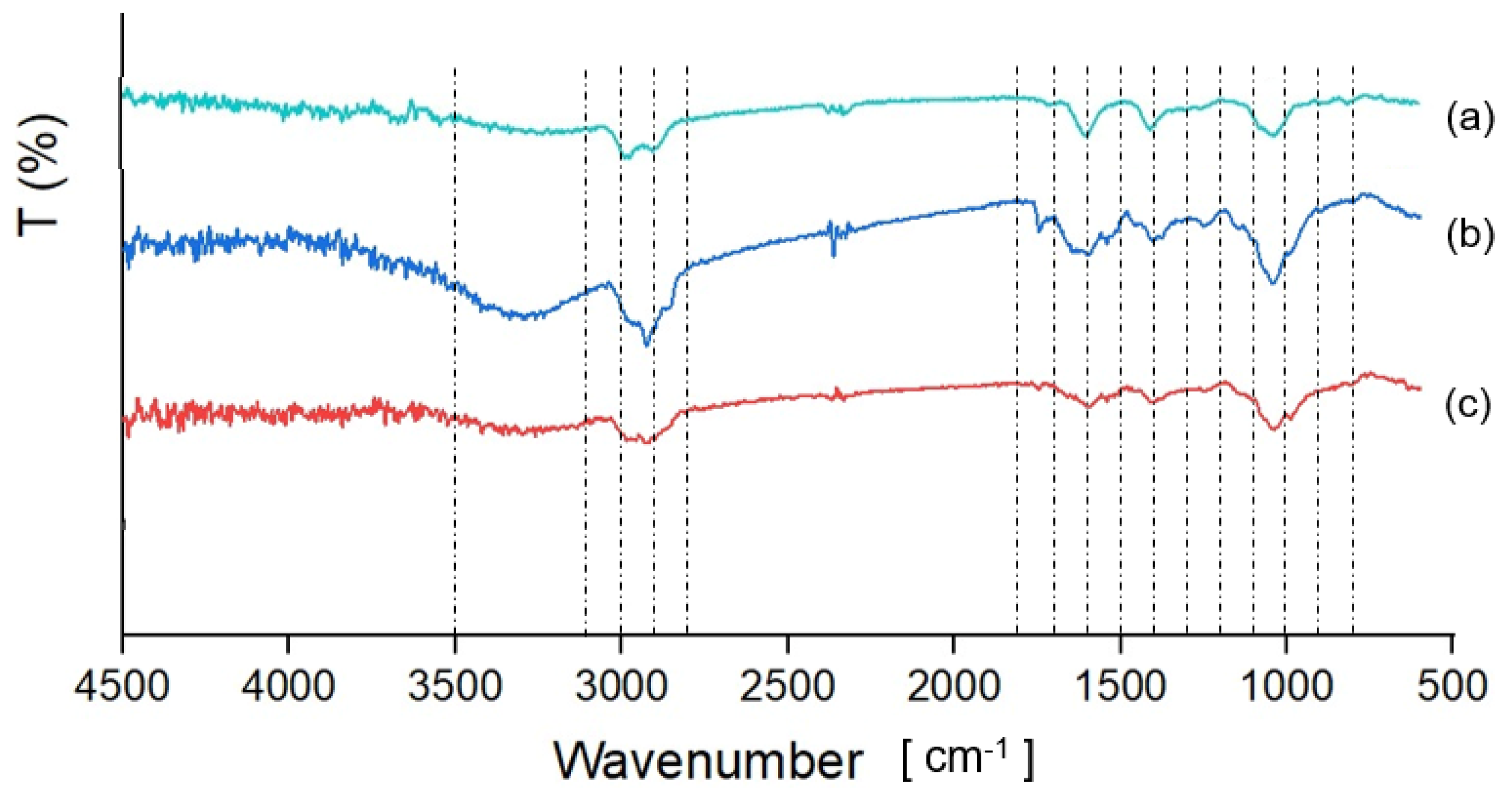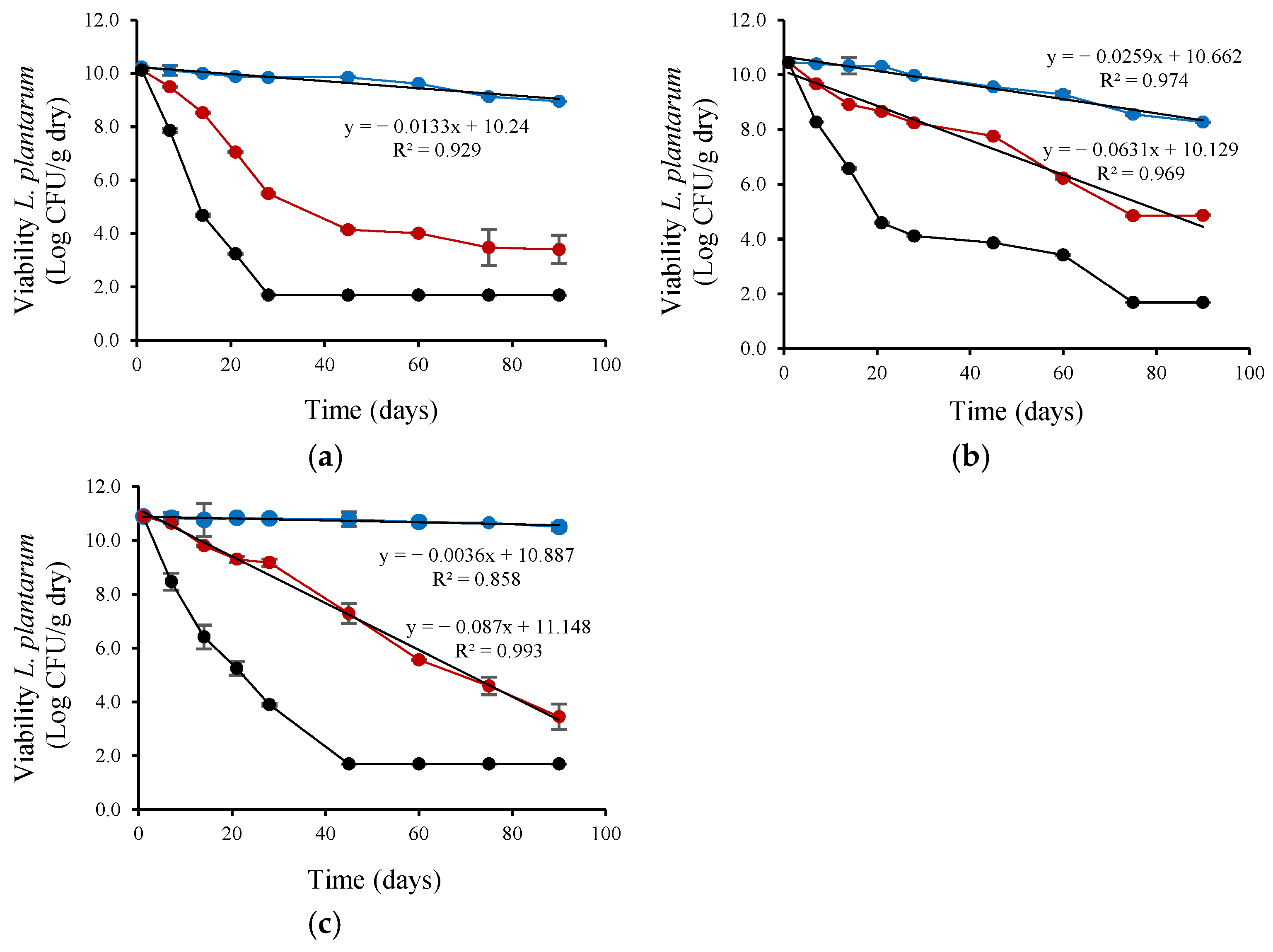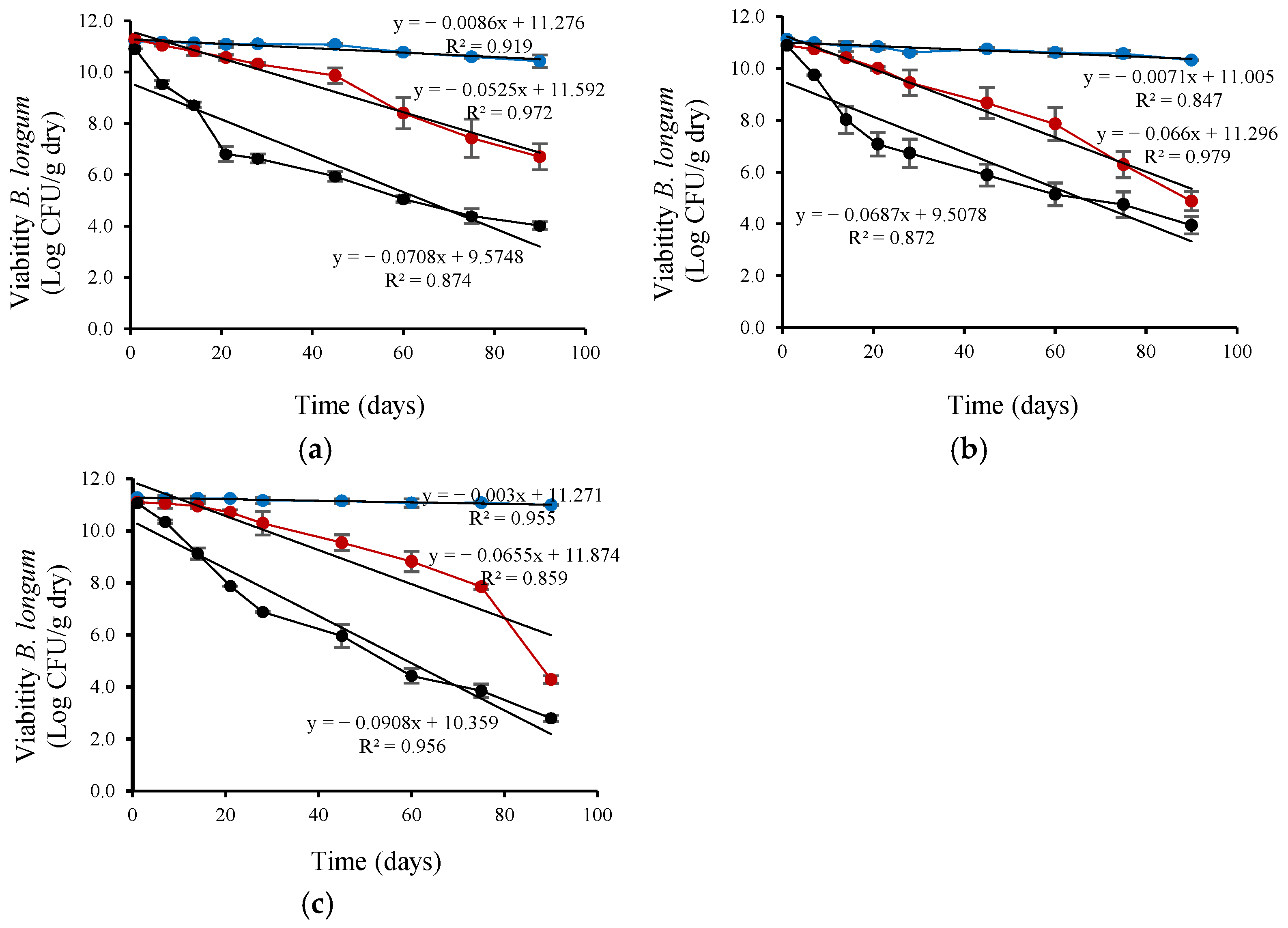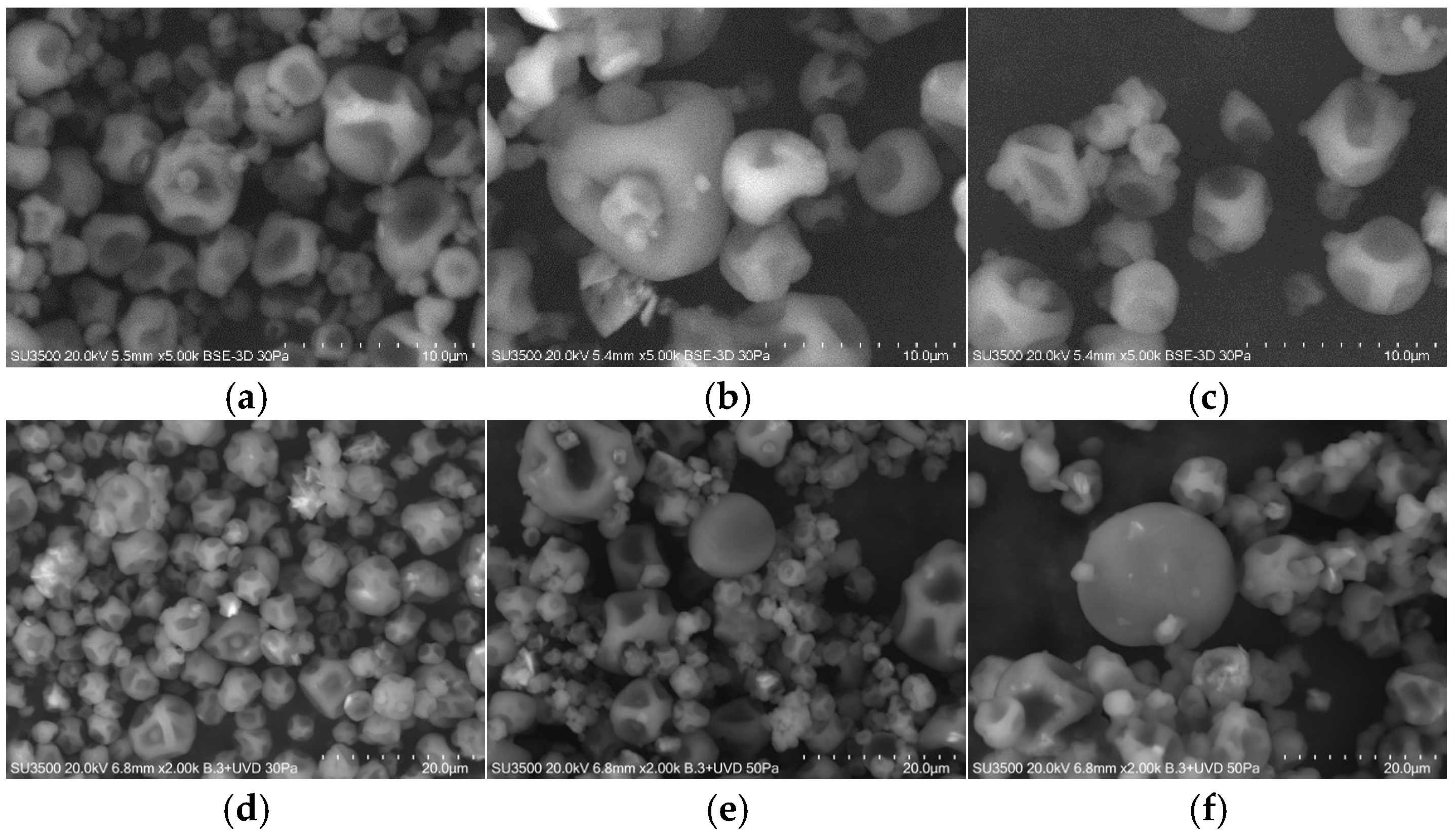Viability of Microencapsulated Probiotics in Cross-Linked Alginate Matrices and Chia Seed or Flaxseed Mucilage During Spray-Drying and Storage
Abstract
1. Introduction
2. Materials and Methods
2.1. Media and Cultivation Conditions
2.2. Extraction of the Chia Seed and Flaxseed Mucilage
2.3. Control Encapsulating Solution Preparation
2.4. Effect of CM or FM on Probiotic Survival After Spray-Drying and Viability During Storage
2.5. Spray-Drying
2.6. Analysis
2.6.1. Physicochemical Characteristics of CM and FM
2.6.2. Enumeration of Viable Probiotics
2.6.3. Storage of Spray-Dried Probiotics Powder
2.6.4. Physical Properties of Probiotic Microcapsules
2.6.5. Statistical Analysis
3. Results
3.1. Physicochemical Characteristics of CM and FM
3.2. Effect of CM or FM on Probiotic Survival After Spray-Drying and Viability During Storage
3.3. Survival Rates of Probiotic Strains During Storage
3.4. Physical Properties of Dry Probiotic Microcapsules
4. Discussion
5. Conclusions
Author Contributions
Funding
Institutional Review Board Statement
Informed Consent Statement
Data Availability Statement
Acknowledgments
Conflicts of Interest
References
- Mordor Intelligence. Probiotics Market Size—Industry Report on Share, Growth Trends & Forecasts Analysis (2025–2030). 2024. Available online: https://www.mordorintelligence.com/industry-reports/probiotics-market (accessed on 2 December 2024).
- FAO. Probiotics in food Health and nutritional properties and guidelines for evaluation. In Report of a Joint FAO/WHO Working Group Report on Drafting Guidelines for the Evaluation of Probiotics in Food, London, ON, Canada, 30 April–1 May 2002; FAO: Rome, Italy, 2006. [Google Scholar]
- Chen, J.; Chen, X.; Ho, C.L. Recent development of probiotic Bifidobacteria for treating human diseases. Front. Bioeng. Biotechnol. 2021, 9, 770248. [Google Scholar] [CrossRef]
- Reiriz, M.; Beltrán-Velasco, A.I.; Echeverry-Alzate, V.; Martínez-Miguel, E.; Gómez-Senent, S.; Uceda, S.; Clemente-Suárez, V.J. Bifidobacterium infantis and Bifidobacterium breve improve symptomatology and neuronal damage in neurodegenerative disease: A systematic review. Nutrients 2025, 17, 391. [Google Scholar] [CrossRef]
- Li, J.; Wang, J.; Wang, M.; Zheng, L.; Cen, Q.; Wang, F.; Zhu, L.; Pang, R.; Zhang, A. Bifidobacterium: A probiotic for the prevention and treatment of depression. Front. Microbiol. 2023, 14, 1174800. [Google Scholar] [CrossRef]
- Tamtaji, O.R.; Taghizadeh, M.; Daneshvar Kakhaki, R.; Kouchaki, E.; Bahmani, F.; Borzabadi, S.; Oryan, S.; Mafi, A.; Asemi, Z. Clinical and metabolic response to probiotic administration in people with Parkinson’s disease: A randomized, double-blind, placebo-controlled trial. Clin. Nutr. 2018, 5, 1031–1035. [Google Scholar] [CrossRef]
- Dargenio, V.N.; Cristofori, F.; Brindicci, V.F.; Schettini, F.; Dargenio, C.; Castellaneta, S.P.; Iannone, A.; Francavilla, R. Impact of Bifidobacterium longum Subspecies infantis on pediatric gut health and nutrition: Current evidence and future directions. Nutrients 2024, 16, 3510. [Google Scholar] [CrossRef]
- Patterson, E.; Tan, H.T.T.; Groeger, D.; Andrews, M.; Buckley, M.; Murphy, E.F.; Groeger, J.A. Bifidobacterium longum 1714 improves sleep quality and aspects of well-being in healthy adults: A randomized, double-blind, placebo-controlled clinical trial. Sci. Rep. 2024, 14, 3725. [Google Scholar] [CrossRef] [PubMed]
- Zheng, J.; Wittouck, S.; Salvetti, E.; Franz, C.; Harris, H.; Mattarelli, P.; O’Toole, P.W.; Pot, B.; Vandamme, P.; Walter, J.; et al. A taxonomic note on the genus Lactobacillus: Description of 23 novel genera, emended description of the genus Lactobacillus beijerinck 1901, and union of Lactobacillaceae and Leuconostocaceae. Int. J. Syst. Evol. Microbiol. 2020, 70, 2782–2858. [Google Scholar] [CrossRef]
- Kassayová, M.; Bobrov, N.; Strojn, L.; Kisková, T.; Bomba, A. Preventive effects of probiotic bacteria Lactobacillus plantarum and dietary fiber in chemically-induced mammary carcinogenesis. Anticancer Res. 2014, 34, 4969. [Google Scholar] [PubMed]
- Khan, I.; Wei, J.; Li, A.; Liu, Z.; Yang, P.; Jing, Y.; Chen, X.; Zhao, T.; Bai, Y.; Zha, L. Lactobacillus plantarum strains attenuated DSS-induced colitis in mice by modulating the gut microbiota and immune response. Int. Microbiol. Off. J. Span. Soc. Microbiol. 2022, 25, 587–603. [Google Scholar] [CrossRef]
- Beltrán-Velasco, A.I.; Reiriz, M.; Uceda, S.; Echeverry-Alzate, V. Lactiplantibacillus (Lactobacillus) plantarum as a complementary treatment to improve symptomatology in neurodegenerative disease: A systematic review of Open Access Literature. Int. J. Mol. Sci. 2024, 25, 3010. [Google Scholar] [CrossRef] [PubMed]
- Guo, H.; Yu, L.; Tian, F.; Chen, W.; Zhai, Q. The Potential Therapeutic Role of Lactobacillaceae rhamnosusfor Treatment of Inflammatory Bowel Disease. Foods 2023, 12, 692. [Google Scholar] [CrossRef]
- Naklong, K.; Therdtatha, P.; Sumonsiri, N.; Leksawasdi, N.; Techapun, C.; Rachtanapun, P.; Taesuwan, S.; Nunta, R.; Khemacheewakul, J. Microencapsulation of Bifidobacterium breve to enhance microbial cell viability in green soybean yogurt. Fermentation 2023, 9, 296. [Google Scholar] [CrossRef]
- Meena, K.K.; Taneja, N.; Ojha, A.; Meena, S. Application of spray-drying and freeze-drying for microencapsulation of lactic acid bacteria: A review. Ann. Phytomed. 2023, 12, 706–716. [Google Scholar] [CrossRef]
- Bustamante, M.; Laurie-Martínez, L.; Vergara, D.; Campos-Vega, R.; Rubilar, M.; Shene, C. Effect of three polysaccharides (inulin, and mucilage from chia and flax seeds) on the survival of probiotic bacteria encapsulated by spray drying. Appl. Sci. 2020, 10, 4623. [Google Scholar] [CrossRef]
- Soukoulis, C.; Gaiani, C.; Hoffmann, L. Plant seed mucilage as emerging biopolymer in food industry applications. Curr. Opin. Food Sci. 2018, 22, 28–42. [Google Scholar] [CrossRef]
- Muñoz, L. Mucilage from Chia Seeds (Salvia hispanica): Microestructure, Physico-Chemical Characterization and Applications in Food Industry. Ph.D. Thesis, Pontificia Universidad Católica de Chile, Santiago, Chile, 2012. [Google Scholar]
- Puligundla, P.; Lim, S. A review of extraction techniques and food applications of flaxseed mucilage. Foods 2022, 11, 1677. [Google Scholar] [CrossRef] [PubMed]
- Silva, L.A.; Sinnecker, P.; Cavalari, A.A.; Sato, A.C.K.; Perrechil, F.A. Extraction of chia seed mucilage: Effect of ultrasound application. Food Chem. Adv. 2022, 1, 100024. [Google Scholar] [CrossRef]
- Xing, X.; Hsieh, Y.S.Y.; Yap, K.; Ang, M.E.; Lahnstein, J.; Tucker, M.R.; Burton, R.A.; Bulone, V. Isolation and structural elucidation by 2D NMR of planteose, a major oligosaccharide in the mucilage of chia (Salvia hispanica L.) seeds. Carbohydr. Polym. 2017, 175, 231–240. [Google Scholar] [CrossRef]
- Muñoz, L.; Cobos, A.; Diaz, O.; Aguilera, J.M. Chia seeds: Microstructure, mucilage extraction and hydration. J. Food Eng. 2012, 108, 216–224. [Google Scholar] [CrossRef]
- Chiang, J.H.; Ong, D.S.M.; Ng, F.S.K.; Hua, X.Y.; Tay, W.L.W.; Henry, C.J. Application of chia (Salvia hispanica) mucilage as an ingredient replacer in foods. Trends Food Sci. Technol. 2021, 115, 105–116. [Google Scholar] [CrossRef]
- da Silveira Ramos, I.F.; Magalhães, L.M.; do O Pessoa, C.; Pinheiro Ferreira, P.M.; dos Santos Rizzo, M.; Osajima, J.A.; Cavalcanti Silva-Filho, E.; Nunes, C.; Raposo, F.; Coimbra, M.A.; et al. New properties of chia seed mucilage (Salvia hispanica L.) and potential application in cosmetic and pharmaceutical products. Ind. Crops Prod. 2021, 171, 113981. [Google Scholar] [CrossRef]
- Zhang, W.; Xu, S.; Wang, Z.; Yang, R.; Lu, R. Demucilaging and dehulling flaxseed with a wet process. LWT Food Sci. Technol. 2009, 42, 1193–1198. [Google Scholar] [CrossRef]
- Cui, W.; Mazza, G.; Biliaderis, C.G. Chemical structure, molecular size distributions, and rheological properties of flaxseed gum. J. Agric. Food Chem. 1994, 42, 1891–1895. [Google Scholar] [CrossRef]
- Khalloufi, S.; Corredig, M.; Goff, H.D.; Alexander, M. Flaxseed gums and their adsorption on whey protein-stabilized oil-in-water emulsions. Food Hydrocoll. 2009, 23, 611–618. [Google Scholar] [CrossRef]
- Gibbs, B.F.; Kermasha, S.; Alli, I.; Mulligan, C.N. Encapsulation in the food industry: A review. Int. J. Food Sci. Nutr. 1999, 50, 213–224. [Google Scholar]
- Gullifa, G.; Risoluti, R.; Mazzoni, C.; Barone, L.; Papa, E.; Battistini, A.; Martin Fraguas, R.; Materazzi, S. Microencapsulation by a spray drying approach to produce innovative probiotics-based products extending the shelf-life in non-refrigerated conditions. Molecules 2023, 28, 860. [Google Scholar] [CrossRef]
- Piñón-Balderrama, C.I.; Leyva-Porras, C.; Terán-Figueroa, Y.; Espinosa-Solís, V.; Álvarez-Salas, C.; Saavedra-Leos, M.Z. Encapsulation of active ingredients in food industry by spray-drying and nano spray-drying technologies. Processes 2020, 8, 889. [Google Scholar] [CrossRef]
- Strobel, S.A.; Allen, K.; Roberts, C.; Jimenez, D.; Scher, H.B.; Jeoh, T. Industrially-scalable microencapsulation of plant beneficial bacteria in dry cross-linked alginate matrix. Ind. Biotechnol. 2018, 14, 138–147. [Google Scholar] [CrossRef]
- de Man, J.C.; Rogosa, M.; Sharpe, M.E. A medium for the cultivation of Lactobacilli. J. Appl. Bacteriol. 1960, 60, 130–135. [Google Scholar] [CrossRef]
- Bustamante, M.; Villarroel, M.; Rubilar, M.; Shene, C. Lactobacillus acidophilus La-05 encapsulated by spray drying: Effect of mucilage and protein from flaxseed (Linum usitatissimum L.). LWT Food Sci. Technol. 2015, 62, 1162–1168. [Google Scholar] [CrossRef]
- AOAC. Official Methods of AOAC International, 16th ed.; AOAC: Arlington, VA, USA, 1995. [Google Scholar]
- Sciarini, L.S.; Maldonado, F.; Ribotta, P.D.; Pérez, G.T.; León, A.E. Chemical composition and functional properties of Gleditsia triacanthos gum. Food Hydrocoll. 2009, 23, 306–313. [Google Scholar] [CrossRef]
- Joshi, M.; Adhikari, B.; Aldred, P.; Panozzo, J.F.; Kasapis, S. Physicochemical and functional properties of lentil protein isolates prepared by different drying methods. Food Chem. 2011, 129, 1513–1522. [Google Scholar] [CrossRef]
- Simpson, P.J.; Stanton, C.; Fitzgerald, G.F.; Ross, R.P. Intrinsic tolerance of Bifidobacterium species to heat and oxygen and survival following spray drying and storage. J. Appl. Microbiol. 2005, 99, 493–501. [Google Scholar] [CrossRef] [PubMed]
- Lapsiri, W.; Bhandari, B.; Wanchaitanawong, P. Viability of Lactobacillus plantarum TISTR 2075 in Different Protectants during Spray Drying and Storage. Drying Technol. 2012, 30, 1407–1412. [Google Scholar] [CrossRef]
- Timilsena, Y.P.; Adhikari, R.; Kasapis, S.; Adhikari, B. Molecular and functional characteristics of purified gum from Australian chia seeds. Carbohydr. Polym. 2016, 136, 128–136. [Google Scholar] [CrossRef]
- Barbary, O.M.; Al-Sohaimy, S.A.; El-Saadani, M.A.; Zeitoun, A.M.A. Extraction, composition and physicochemical properties of flaxseed mucilage. J. Adv. Agric. Res. 2009, 14, 605–621. [Google Scholar]
- Toğrul, H.; Arslan, N. Flow properties of sugar beet pulp cellulose and intrinsic viscosity–molecular weight relationship. Carbohydr. Polym. 2003, 54, 63–71. [Google Scholar] [CrossRef]
- Cerqueira, M.A.; Souza, B.W.S.; Simões, J.; Teixeira, J.A.; Domingues, M.R.M.; Coimbra, M.A.; Vicente, A.A. Structural and thermal characterization of galactomannans from non-conventional sources. Carbohydr. Polym. 2011, 83, 179–185. [Google Scholar] [CrossRef]
- Ma, F.; Zhang, Y.; Liu, N.; Zhang, J.; Tan, G.; Kannan, B.; Liu, X.; Bell, A.E.; Tikkanen-kaukanen, C. Chemical components and emulsification properties of mucilage from Dioscorea opposita Thunb. Food Chem. 2017, 228, 315–322. [Google Scholar] [CrossRef]
- Silva, S.H.; Neves, I.C.O.; Oliveira, N.L.; Oliveira, A.C.F.; Lago, A.M.T.; Giarola, T.M.O.; Resende, J.V. Extraction processes and characterization of the mucilage obtained from green fruits of Pereskia aculeata Miller. Ind. Crops Prod. 2019, 140, 111716. [Google Scholar] [CrossRef]
- Wang, Q.; Ellis, P.R.; Ross-Murphy, S.B. Dissolution kinetics of guar gum powders-II. Effects of concentration and molecular weight. Carbohydr. Polym. 2003, 53, 75–83. [Google Scholar] [CrossRef]
- Coimbra, M.A.; Barros, A.; Rutledge, D.N.; Delgadillo, I. FTIR spectroscopy as a tool for the analysis of olive pulp cell-wall polysaccharide extracts. Carbohydr. Res. 1999, 317, 145–154. [Google Scholar] [CrossRef]
- El Atouani, S.; Bentiss, F.; Reani, A.; Zrid, R.; Belattmania, Z.; Pereira, L.; Mortadi, A.; Cherkaoui, O.; Sabour, B. The invasive brown seaweed Sargassum muticum as new resource for alginate in Morocco: Spectroscopic and rheological characterization. Phycol. Res. 2016, 64, 185–193. [Google Scholar] [CrossRef]
- Helmiyati; Aprilliza, M. Characterization and properties of sodium alginate from brown algae used as an ecofriendly superabsorbent. IOP Conf. Ser. Mater. Sci. Eng. 2017, 188, 012019. [Google Scholar] [CrossRef]
- Garakani, S.S.; Khanmohammadi, M.; Atoufi, Z.; Kamrava, S.K.; Setayeshmehr, M.; Alizadeh, R.; Faghihi, F.; Bagher, Z.; Davachi, S.M.; Abbaspourrad, A. Fabrication of chitosan/agarose scaffolds containing extracellular matrix for tissue engineering applications. Int. J. Biol. Macromol. 2019, 143, 533–545. [Google Scholar] [CrossRef]
- Anokhina, T.; Dmitrieva, E.; Volkov, A. Recovery of model pharmaceutical compounds from water and organic solutions with alginate-based composite membranes. Membranes 2022, 12, 235. [Google Scholar] [CrossRef]
- Roy, D. Technological aspects related to the use of bifidobacteria in dairy products. Le Lait 2005, 85, 39–56. [Google Scholar] [CrossRef]
- Tan, L.L.; Mahotra, M.; Chan, S.Y.; Loo, S.C.J. In situ alginate crosslinking during spray-drying of lactobacilli probiotics promotes gastrointestinal-targeted delivery. Carbohydr. Polym. 2022, 286, 119279. [Google Scholar] [CrossRef] [PubMed]
- Gharsallaoui, A.; Roudaut, G.; Chambin, O.; Voilley, A.; Saurel, R. Applications of spray-drying in microencapsulation of food ingredients: An overview. Food Res. Int. 2007, 40, 1107–1121. [Google Scholar] [CrossRef]
- Koocheki, A.; Mortazavi, S.A.; Shahidi, F.; Razavi, S.; Kadkhodaee, R.; Milani, J.M. Optimization of mucilage extraction from Qodume shirazi seed (Alyssum homolocarpum) using response surface methodology. J. Food Process Eng. 2010, 33, 861–882. [Google Scholar] [CrossRef]
- Souid, S.; Brahmi, D.; Lepesant, J.A.; Zourgui, L. Cactus (Opuntia ficus indica) extract improves endoplasmic reticulum stress in Drosophila melanogaster. Afr. J. Biotechnol. 2011, 10, 14699–14705. [Google Scholar] [CrossRef]
- Campos, B.E.; Ruivo, T.D.; da Silva Scapim, M.R.; Madrona, G.S.; Bergamasco, R.D.C. Optimization of the mucilage extraction process from chia seeds and application in ice cream as a stabilizer and emulsifier. LWT-Food Sci. Technol. 2016, 65, 874–883. [Google Scholar] [CrossRef]
- Lin, K.Y.; Daniel, J.R.; Whister, R.L. Structure of chia seed polysaccharide exudate. Carbohydr. Polym. 1994, 23, 13–18. [Google Scholar] [CrossRef]
- Kaewmanee, T.; Bagnasco, L.; Benjakul, S.; Lanteri, S.; Morelli, C.F.; Speranza, G.; Cosulich, M.E. Characterization of mucilages extracted from seven Italian cultivars of flax. Food Chem. 2014, 148, 60–69. [Google Scholar] [CrossRef] [PubMed]
- Maskan, M.; Gogus, F. Effect of sugar on the rheological properties of sunflower oil–water emulsions. J. Food Eng. 2000, 43, 173–177. [Google Scholar] [CrossRef]
- Capitani, M.I.; Corzo-Rios, L.J.; Chel-Guerrero, L.A.; Betancur-Ancona, D.A.; Nolasco, S.M.; Tomás, M.C. Rheological properties of aqueous dispersions of chia (Salvia hispanica L.) mucilage. J. Food Eng. 2015, 149, 70–77. [Google Scholar] [CrossRef]
- Roulard, R.; Petit, E.; Mesnard, F.; Rhazi, L. Molecular investigations of flaxseed mucilage polysaccharides. Int. J. Biol. Macromol. 2016, 86, 840–847. [Google Scholar] [CrossRef]
- Fritzen-Freire, C.B.; Prudêncio, E.S.; Amboni, R.D.M.C.; Pinto, S.S.; Negrão-Murakami, A.N.; Murakami, F.S. Microencapsulation of bifidobacteria by spray drying in the presence of prebiotics. Food Res. Int. 2012, 45, 306–312. [Google Scholar] [CrossRef]
- Hussain, N.; Ishak, I.; Sulaiman, R.; Fauzi, N.M.; Coorey, R. Influence of processing conditions on rheological properties of aqueous extract chia (Salvia hispanica L.) mucilage. Food Res. 2020, 4, 227–236. [Google Scholar] [CrossRef]
- Karaś, M.; Szymanowska, U.; Borecka, M.; Jakubczyk, A.; Kowalczyk, D. Antioxidant properties of wafers with added pumpkin seed flour subjected to in vitro digestion. Appl. Sci. 2024, 14, 5129. [Google Scholar] [CrossRef]
- Dubois, F.; Musa, C.; Duponchel, B.; Tidahy, L.; Sécordel, X.; Mallard, I.; Delattre, F. Nuclear magnetic resonance and calorimetric investigations of extraction mode on flaxseed gum composition. Polymers 2020, 12, 2654. [Google Scholar] [CrossRef] [PubMed]
- Ananta, E.; Volkert, M.; Knorr, D. Cellular injuries and storage stability of spray-dried Lactobacillus rhamnosus GG. Int. Dairy J. 2005, 15, 399–409. [Google Scholar] [CrossRef]
- Barbosa-Cánovas, G.V.; Ortega-Rivas, E.; Juliano, P.; Yan, H. Food Powders: Physical Properties, Processing and Functionality; Kluwer Academic: New York, NY, USA, 2005. [Google Scholar]
- Hernández-López, Z.; Rangel-Vargas, E.; Castro-Rosas, J.; Gómez-Aldapa, C.A.; Cadena-Ramírez, A.; Acevedo-Sandoval, O.A.; Cordillo-Martínez, A.J.; Falfán-Cortés, R.N. Optimization of a spray-drying process for the production of maximally viable microencapsulated Lactobacillus pentosus using a mixture of starch-pulque as wall material. LWT 2018, 95, 216–222. [Google Scholar] [CrossRef]








| Composition | Encapsulation Solution | ||
|---|---|---|---|
| Control | CM | FM | |
| Sodium alginate (4% w/v) | x | x | x |
| Succinic acid (2%, w/v) | x | x | x |
| NH4OH | x | x | x |
| CaHPO4 (0.5%, w/v) | x | x | x |
| Chia seed mucilage (0.4%, w/v) | x | ||
| Flaxseed mucilage (0.4%, w/v) | x | ||
| Constituents | Unit | CM | FM |
|---|---|---|---|
| Yield a | % | 7.90 ± 1.46 | 9.85 ± 0.86 |
| Moisture | % | 11.29 | 9.23 |
| Protein | % | 13.14 | 12.12 |
| Fat | % | 3.36 | 0.62 |
| Crude fiber | % | 4.11 | n.d. |
| Ash | % | 12.82 | 11.85 |
| Non-nitrogenous extract | % | 55.28 | 66.18 |
| Monosaccharides b | |||
| Arabinose | % | n.d. | 1.54 ± 0.08 |
| Fucose | % | n.d. | n.d. |
| Galacturonic acid | % | n.d. | 2.28 ± 0.28 |
| Glucose | % | 36.80 ± 1.83 | 37.50 ± 1.06 |
| Glucuronic acid | % | n.d. | 13.76 ± 1.08 |
| Mannose | % | n.d. | 2.79 ± 0.15 |
| Rhamnose | % | 17.94 ± 0.85 | 4.62 ± 0.41 |
| Xylose | % | n.d. | n.d. |
| Energy | Kcal/100 g | 303.92 | 318.78 |
| Bulk density c | kg/m3 | 429.89 ± 7.96 | 686.28 ± 14.11 |
| Color b | |||
| L* | 48.15 ± 0.53 | 51.08 ± 0.62 | |
| A* | 4.48 ± 0.22 | 4.65 ± 0.33 | |
| B* | 17.76 ± 0.57 | 17.43 ± 0.50 | |
| Viscosity encapsulating solution added with 0.4% CM or FM c | mPa·s | 9.91 ± 0.30 | 6.09 ± 0.32 |
| Probiotic Strain | Survival †† (%) | ||
|---|---|---|---|
| CM | FM | Control | |
| L. plantarum | 98.66 ± 0.19 a A | 95.53 ± 0.50 b A | 98.43 ± 0.47 a A |
| L. rhamnosus | 92.06 ± 2.91 ab B | 86.65 ± 3.19 b B | 97.50 ± 0.69 a AB |
| B. infantis | 96.61 ± 0.53 ab A | 94.03 ± 2.87 b A | 98.12 ± 0.26 a AB |
| B. longum | 98.45 ± 0.37 a A | 98.39 ± 0.65 a A | 96.59 ± 0.80 b B |
| Soluble Fiber † | Viability (Log CFU/g Powder) | |||
|---|---|---|---|---|
| Day 1 | Day 90 | |||
| 4 °C | 4 °C | 25 °C | 37 °C | |
| L. plantarum | ||||
| CM | 10.45 ± 0.08 d | 08.27 ± 0.10 f | 4.87 ± 0.30 bc | 1.69 ± 0.00 c |
| FM | 10.24 ± 0.01 d | 08.95 ± 0.00 e | 3.40 ± 0.34 e | 1.69 ± 0.00 c |
| Control | 10.89 ± 0.01 c | 10.50 ± 0.22 abc | 3.45 ± 0.30 de | 1.69 ± 0.00 c |
| L. rhamnosus | ||||
| CM | 10.44 ± 0.05 d | 09.02 ± 0.00 e | 1.69 ± 0.01 f | 1.69 ± 0.00 c |
| FM | 09.27 ± 0.04 e | 06.99 ± 0.03 g | 2.19 ± 0.50 f | 1.69 ± 0.00 c |
| Control | 10.11 ± 0.07 d | 09.29 ± 0.27 de | 1.69 ± 0.00 f | 1.69 ± 0.00 c |
| B. infantis | ||||
| CM | 11.33 ± 0.30 b | 09.64 ± 0.41 d | 4.25 ± 0.21 cde | 1.69 ± 0.00 c |
| FM | 11.19 ± 0.09 bc | 10.21 ± 0.02 c | 5.49 ± 0.30 b | 1.69 ± 0.00 c |
| Control | 11.77 ± 0.11 a | 10.97 ± 0.19 ab | 7.45 ± 0.32 a | 2.53 ± 0.56 b |
| B. longum | ||||
| CM | 10.89 ± 0.01 bc | 10.32 ± 0.02 c | 4.91 ± 0.12 bc | 4.00 ± 0.24 a |
| FM | 10.94 ± 0.05 bc | 10.47 ± 0.19 bc | 6.76 ± 0.38 a | 4.02 ± 0.13 a |
| Control | 11.07 ± 0.04 bc | 10.99 ± 0.01 a | 4.32 ± 0.27 cd | 2.79 ± 0.09 b |
| Probiotic Strain | Spray-Drying Medium † | Ea (kJ/mol K) | R2 |
|---|---|---|---|
| L. plantarum | C/CM | 50.02 | 0.924 |
| C/FM | 69.13 | 0.991 | |
| C | 91.80 | 0.994 | |
| L. rhamnosus | C/CM | 76.31 | 0.977 |
| C/FM | 47.41 | 0.994 | |
| C | 92.98 | 0.997 | |
| B. infantis | C/CM | 60.05 | 0.977 |
| C/FM | 75.60 | 0.977 | |
| C | 66.153 | 0.978 | |
| B. longum | C/CM | 66.19 | 0.999 |
| C/FM | 66.00 | 0.988 | |
| C | 80.21 | 0.993 |
| Probiotic Strain | Moisture † (%) | Particle Size †† (μm) | ||||
|---|---|---|---|---|---|---|
| CM | FM | Control | CM | FM | Control | |
| L. plantarum | 16.54 ± 0.48 | 16.91 ± 0.67 | 16.25 ± 0.27 | 8.50 ± 0.53 b | 10.59 ± 0.66 a | 8.22 ± 1.00 b |
| L. rhamnosus | 15.03 ± 0.72 | 16.70 ± 0.85 | 15.33 ± 0.71 | 8.50 ± 0.53 b | 11.82 ± 0.74 a | 9.87 ± 1.08 ab |
| B. infantis | 14.96 ± 0.68 | 14.03 ± 0.32 | 13.76 ± 0.61 | 7.07 ± 0.00 b | 11.40 ± 0.74 a | 9.53 ± 1.25 a |
| B. longum | 13.25 ± 0.35 | 12.66 ± 0.31 | 14.08 ± 0.51 | 8.50 ± 0.53 b | 10.21 ± 0.66 a | 9.49 ± 0.59 ab |
Disclaimer/Publisher’s Note: The statements, opinions and data contained in all publications are solely those of the individual author(s) and contributor(s) and not of MDPI and/or the editor(s). MDPI and/or the editor(s) disclaim responsibility for any injury to people or property resulting from any ideas, methods, instructions or products referred to in the content. |
© 2025 by the authors. Licensee MDPI, Basel, Switzerland. This article is an open access article distributed under the terms and conditions of the Creative Commons Attribution (CC BY) license (https://creativecommons.org/licenses/by/4.0/).
Share and Cite
Bustamante, M.; Oomah, B.D.; Burgos-Díaz, C.; Vergara, D.; Flores, L.; Shene, C. Viability of Microencapsulated Probiotics in Cross-Linked Alginate Matrices and Chia Seed or Flaxseed Mucilage During Spray-Drying and Storage. Microorganisms 2025, 13, 1457. https://doi.org/10.3390/microorganisms13071457
Bustamante M, Oomah BD, Burgos-Díaz C, Vergara D, Flores L, Shene C. Viability of Microencapsulated Probiotics in Cross-Linked Alginate Matrices and Chia Seed or Flaxseed Mucilage During Spray-Drying and Storage. Microorganisms. 2025; 13(7):1457. https://doi.org/10.3390/microorganisms13071457
Chicago/Turabian StyleBustamante, Mariela, B. Dave Oomah, César Burgos-Díaz, Daniela Vergara, Liset Flores, and Carolina Shene. 2025. "Viability of Microencapsulated Probiotics in Cross-Linked Alginate Matrices and Chia Seed or Flaxseed Mucilage During Spray-Drying and Storage" Microorganisms 13, no. 7: 1457. https://doi.org/10.3390/microorganisms13071457
APA StyleBustamante, M., Oomah, B. D., Burgos-Díaz, C., Vergara, D., Flores, L., & Shene, C. (2025). Viability of Microencapsulated Probiotics in Cross-Linked Alginate Matrices and Chia Seed or Flaxseed Mucilage During Spray-Drying and Storage. Microorganisms, 13(7), 1457. https://doi.org/10.3390/microorganisms13071457









